外研版(2019)选择性必修 第一册Unit 4 Meeting the muse Developing ideas Reading 知识点课件((共23张PPT)2019)选择性必修第一册
文档属性
| 名称 | 外研版(2019)选择性必修 第一册Unit 4 Meeting the muse Developing ideas Reading 知识点课件((共23张PPT)2019)选择性必修第一册 |  | |
| 格式 | pptx | ||
| 文件大小 | 804.3KB | ||
| 资源类型 | 教案 | ||
| 版本资源 | 外研版(2019) | ||
| 科目 | 英语 | ||
| 更新时间 | 2023-03-15 12:21:50 | ||
图片预览

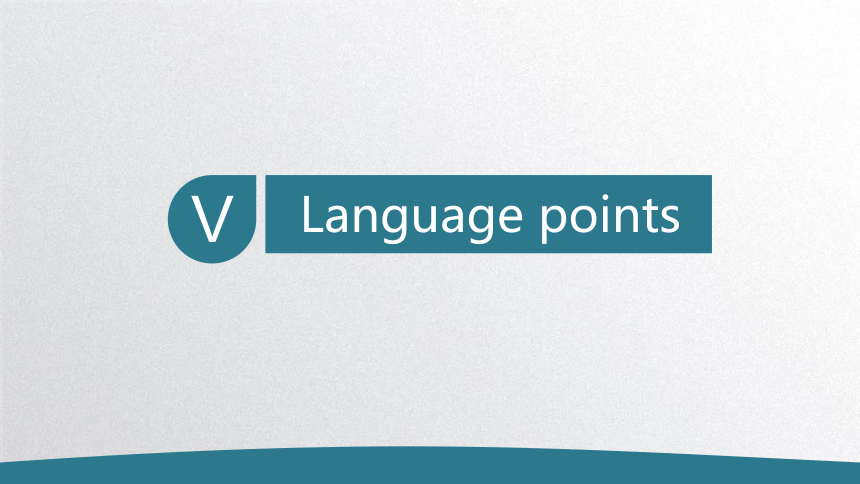
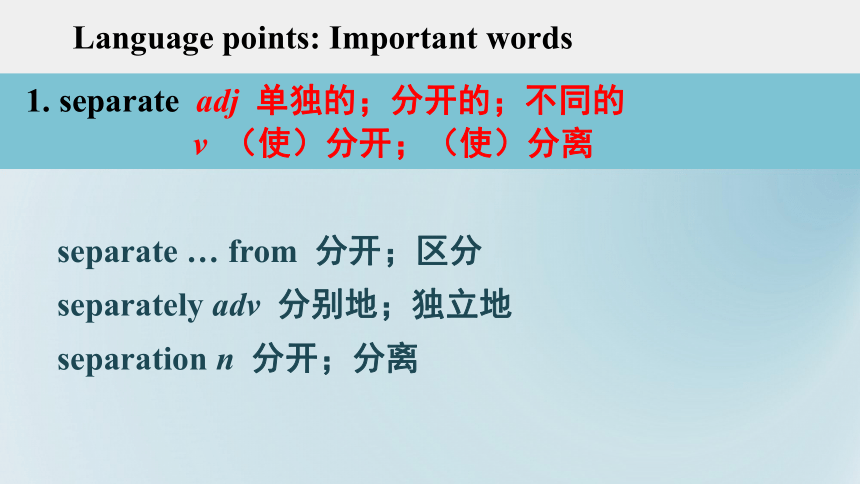
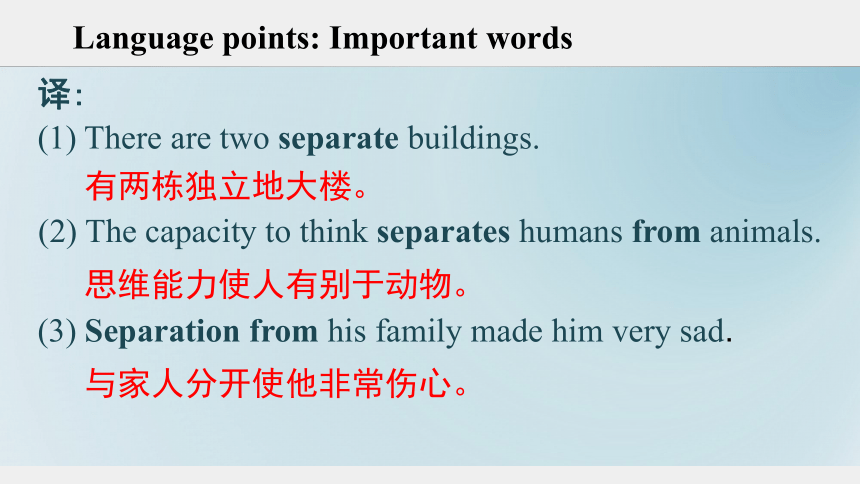
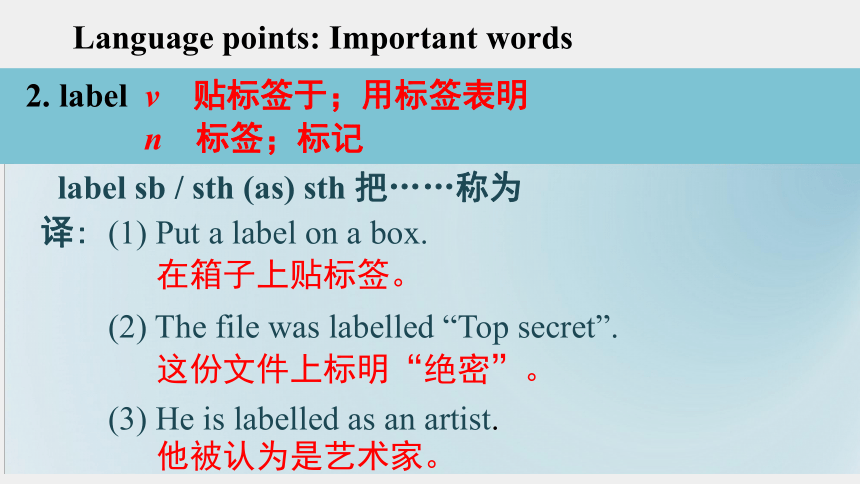
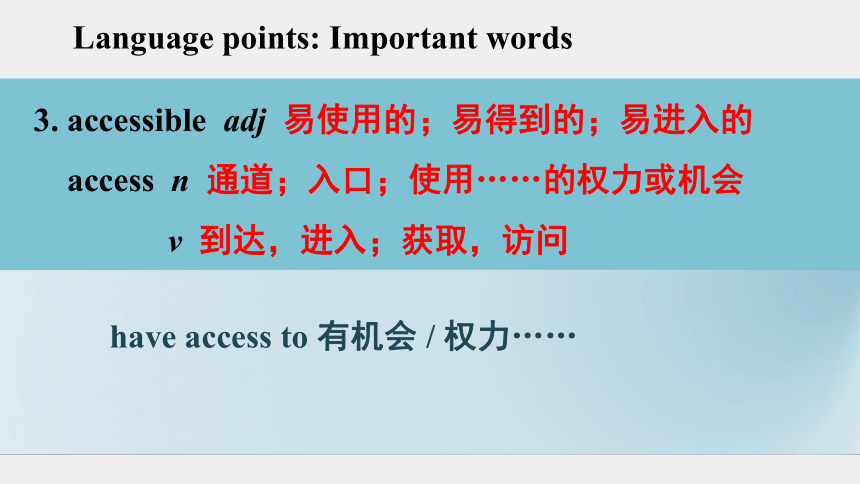
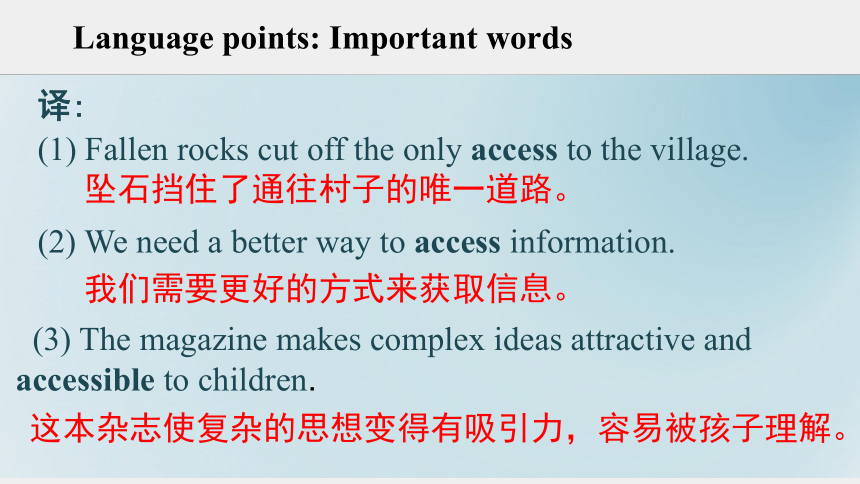
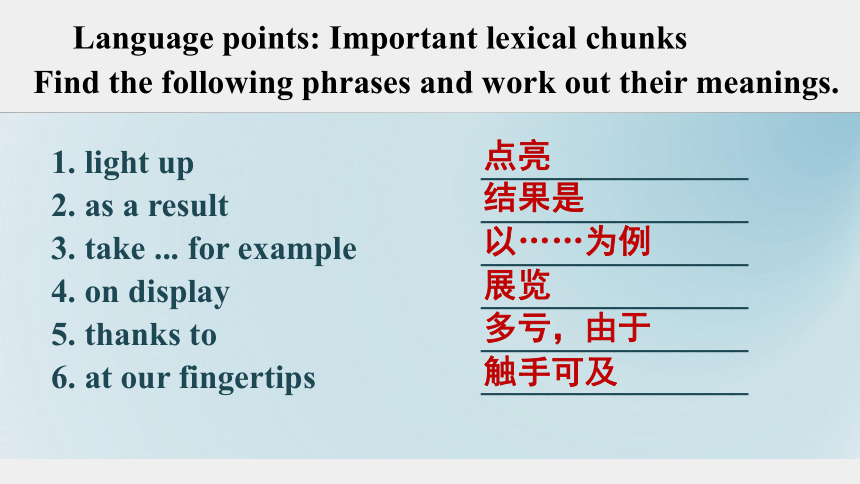
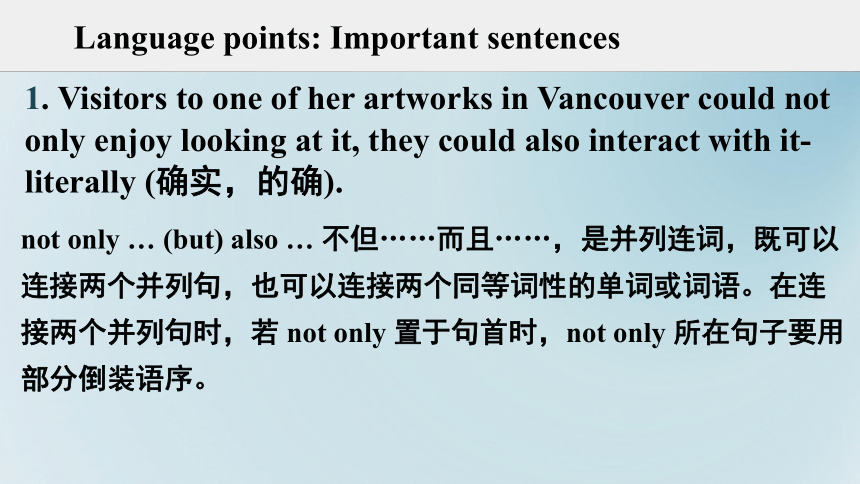
文档简介
(共23张PPT)
Developing ideas — reading
Unit 4 Meeting the muse
Language points
V
Language points: Important words
separate … from 分开;区分
separately adv 分别地;独立地
separation n 分开;分离
1. separate adj 单独的;分开的;不同的
v (使)分开;(使)分离
Language points: Important words
译:
(1) There are two separate buildings.
有两栋独立地大楼。
(2) The capacity to think separates humans from animals.
思维能力使人有别于动物。
(3) Separation from his family made him very sad.
与家人分开使他非常伤心。
Language points: Important words
label sb / sth (as) sth 把……称为
2. label v 贴标签于;用标签表明
n 标签;标记
译: (1) Put a label on a box.
(2) The file was labelled “Top secret”.
(3) He is labelled as an artist.
在箱子上贴标签。
这份文件上标明“绝密”。
他被认为是艺术家。
Language points: Important words
have access to 有机会 / 权力……
3. accessible adj 易使用的;易得到的;易进入的
access n 通道;入口;使用……的权力或机会
v 到达,进入;获取,访问
Language points: Important words
译:
(1) Fallen rocks cut off the only access to the village.
坠石挡住了通往村子的唯一道路。
(2) We need a better way to access information.
我们需要更好的方式来获取信息。
(3) The magazine makes complex ideas attractive and accessible to children.
这本杂志使复杂的思想变得有吸引力,容易被孩子理解。
Language points: Important lexical chunks
1. light up ________________
2. as a result ________________
3. take ... for example ________________
4. on display ________________
5. thanks to ________________
6. at our fingertips ________________
Find the following phrases and work out their meanings.
点亮
结果是
以……为例
展览
多亏,由于
触手可及
Language points: Important sentences
1. Visitors to one of her artworks in Vancouver could not only enjoy looking at it, they could also interact with it- literally (确实,的确).
not only … (but) also … 不但……而且……,是并列连词,既可以连接两个并列句,也可以连接两个同等词性的单词或词语。在连接两个并列句时,若 not only 置于句首时,not only 所在句子要用部分倒装语序。
Language points: Important sentences
1. Visitors to one of her artworks in Vancouver could not only enjoy looking at it, they could also interact with it- literally (确实,的确).
例如:
Not only the students but also their teacher is enjoying the film.
不仅学生就连老师都在欣赏这部电影。
(2) Not only can we interact with art, but also take part in its creation.
我们不仅可以与艺术作品互动,还可以参与到艺术作品的创作中。
Language points: Important sentences
2. Whatever your opinion, people have been expressing their thoughts and ideas through art for thousands of years.
whatever 在句中用作限定词,后接名词短语 your opinion,引导让步状语从句,可以用 no matter what 来替换。
Paraphrase: No matter what you believe, the fact is that people have been using art to express their thoughts and ideas for thousands of years.
Language points: Important sentences
例如:She will buy the painting at whatever price.
无论什么价格,她都会买那副画。
这里whatever是any的意思
2. Whatever your opinion, people have been expressing their thoughts and ideas through art for thousands of years.
Language points: Important sentences
Whatever 的常见用法:
1) whatever还可以用作关系代词,引导名词性从句。
例如:You can choose whatever you like。
你喜欢什么就可以选什么。
2) whatever还可以用作疑问代词,引导疑问句。
例如:Whatever do you mean
你究竟是什么意思?
2. Whatever your opinion, people have been expressing their thoughts and ideas through art for thousands of years.
Language points: Important sentences
3. With new technological tools at our fingertips, more and more people are exploring their creative sides.
Paraphrase: We have new technological tools at hand, which enable people to explore their creative sides.
Language points: Important sentences
3. With new technological tools at our fingertips, more and more people are exploring their creative sides.
with + 介词短语在句中作状语,这个复合结构相当于
as new technological tools are available to us。
With复合结构,即With + 宾语 + 名词 / 形容词 / 副词 / 介词短语 / 非谓语(v-ing / v-ed / to do)在句中表状态或说明背景情况,常做伴随、方式、原因,条件等状语。
With复合结构
Language points: Important sentences
1. with + 宾语 + 名词
He died with his son yet a schoolboy. 他去世时,儿子还是个小学生。
2. with + 名词 + 介词短语
He was asleep with his head on his arms. 他头枕着胳膊睡着了。
3. with + 名词 + 形容词(强调名词的特性或状态)
He often sleeps with the windows open. 他常开着窗睡觉。
4. with + 名词 + 副词
He was lying on the bed with all his clothes on. 他和衣躺在床上。
With复合结构
Language points: Important sentences
5. with + 名词 + -ed 分词 (强调名词是 -ed 分词动作的承受者或动作已经发生)
He sat there with his eyes closed. 他闭目坐在那儿。
6. with + 名词 + -ing 分词 (强调名词是 -ing分词的动作的发出者或某动作,状态正在进行)
I won’t be able to go on holiday with my mother being ill.
因为妈妈有病,我无法去度假。
7. with + 名词 + to do (不定式动作尚未发生)
I can’t go out with all these clothes to wash.
要洗这些衣服,我无法出去了。
Language points: Important sentences
4. However, the increase in the amount and variety of art produced has also raised questions over its overall quality.
Paraphrase: Although the amount and variety of art produced is increasing, its overall quality seems to be reduced.
Language points: Important sentences
4. However, the increase in the amount and variety of art produced has also raised questions over its overall quality.
句中however表转折,起承上启下的作用。the increase in the amount and variety of art produced 在句中作主语;produced过去分词作后置定语,修饰art,表被动;has raised是谓语动词;over是介词,表示“关于”,说明在哪方面产生了问题。
Language points: Important sentences
5. A recent project used technology and data in the same way that Rembrandt used his paints and brushes.
Paraphrase: A recent project used technology and data just like Rembrandt used his paints and brushes.
Language points: Important sentences
5. A recent project used technology and data in the same way that Rembrandt used his paints and brushes.
that在句子中引导定语从句,修饰先行词way,that在从句中作方式状语,可以用 in which 替换。
例如:I don’t like the way that he laughed at me.
paint的复数形式paints表示“(一套)颜料”。
例如:a set of oil paints(一套油画颜料)
Language points: Important sentences
6. The end result, printed in 3D, was a new “Rembrandt painting” created 347 years after the artist’s death.
Paraphrase: The result was that a new “Rembrandt painting” was created by using 3D printing technology 347 years after the artist’s death.
Language points: Important sentences
6. The end result, printed in 3D, was a new “Rembrandt painting” created 347 years after the artist’s death.
本句中,end是名词作定语修饰result,end result 是“最终结果”;printed和created都是过去分词作后置定语,分别修饰result和Rembrandt painting;347 years after the artist’s death 是时间状语。
printed 和created过去分词作后置定语
例如: The student dressed in white is my daughter.
(dressed过去分词作后置定语)
Developing ideas — reading
Unit 4 Meeting the muse
Language points
V
Language points: Important words
separate … from 分开;区分
separately adv 分别地;独立地
separation n 分开;分离
1. separate adj 单独的;分开的;不同的
v (使)分开;(使)分离
Language points: Important words
译:
(1) There are two separate buildings.
有两栋独立地大楼。
(2) The capacity to think separates humans from animals.
思维能力使人有别于动物。
(3) Separation from his family made him very sad.
与家人分开使他非常伤心。
Language points: Important words
label sb / sth (as) sth 把……称为
2. label v 贴标签于;用标签表明
n 标签;标记
译: (1) Put a label on a box.
(2) The file was labelled “Top secret”.
(3) He is labelled as an artist.
在箱子上贴标签。
这份文件上标明“绝密”。
他被认为是艺术家。
Language points: Important words
have access to 有机会 / 权力……
3. accessible adj 易使用的;易得到的;易进入的
access n 通道;入口;使用……的权力或机会
v 到达,进入;获取,访问
Language points: Important words
译:
(1) Fallen rocks cut off the only access to the village.
坠石挡住了通往村子的唯一道路。
(2) We need a better way to access information.
我们需要更好的方式来获取信息。
(3) The magazine makes complex ideas attractive and accessible to children.
这本杂志使复杂的思想变得有吸引力,容易被孩子理解。
Language points: Important lexical chunks
1. light up ________________
2. as a result ________________
3. take ... for example ________________
4. on display ________________
5. thanks to ________________
6. at our fingertips ________________
Find the following phrases and work out their meanings.
点亮
结果是
以……为例
展览
多亏,由于
触手可及
Language points: Important sentences
1. Visitors to one of her artworks in Vancouver could not only enjoy looking at it, they could also interact with it- literally (确实,的确).
not only … (but) also … 不但……而且……,是并列连词,既可以连接两个并列句,也可以连接两个同等词性的单词或词语。在连接两个并列句时,若 not only 置于句首时,not only 所在句子要用部分倒装语序。
Language points: Important sentences
1. Visitors to one of her artworks in Vancouver could not only enjoy looking at it, they could also interact with it- literally (确实,的确).
例如:
Not only the students but also their teacher is enjoying the film.
不仅学生就连老师都在欣赏这部电影。
(2) Not only can we interact with art, but also take part in its creation.
我们不仅可以与艺术作品互动,还可以参与到艺术作品的创作中。
Language points: Important sentences
2. Whatever your opinion, people have been expressing their thoughts and ideas through art for thousands of years.
whatever 在句中用作限定词,后接名词短语 your opinion,引导让步状语从句,可以用 no matter what 来替换。
Paraphrase: No matter what you believe, the fact is that people have been using art to express their thoughts and ideas for thousands of years.
Language points: Important sentences
例如:She will buy the painting at whatever price.
无论什么价格,她都会买那副画。
这里whatever是any的意思
2. Whatever your opinion, people have been expressing their thoughts and ideas through art for thousands of years.
Language points: Important sentences
Whatever 的常见用法:
1) whatever还可以用作关系代词,引导名词性从句。
例如:You can choose whatever you like。
你喜欢什么就可以选什么。
2) whatever还可以用作疑问代词,引导疑问句。
例如:Whatever do you mean
你究竟是什么意思?
2. Whatever your opinion, people have been expressing their thoughts and ideas through art for thousands of years.
Language points: Important sentences
3. With new technological tools at our fingertips, more and more people are exploring their creative sides.
Paraphrase: We have new technological tools at hand, which enable people to explore their creative sides.
Language points: Important sentences
3. With new technological tools at our fingertips, more and more people are exploring their creative sides.
with + 介词短语在句中作状语,这个复合结构相当于
as new technological tools are available to us。
With复合结构,即With + 宾语 + 名词 / 形容词 / 副词 / 介词短语 / 非谓语(v-ing / v-ed / to do)在句中表状态或说明背景情况,常做伴随、方式、原因,条件等状语。
With复合结构
Language points: Important sentences
1. with + 宾语 + 名词
He died with his son yet a schoolboy. 他去世时,儿子还是个小学生。
2. with + 名词 + 介词短语
He was asleep with his head on his arms. 他头枕着胳膊睡着了。
3. with + 名词 + 形容词(强调名词的特性或状态)
He often sleeps with the windows open. 他常开着窗睡觉。
4. with + 名词 + 副词
He was lying on the bed with all his clothes on. 他和衣躺在床上。
With复合结构
Language points: Important sentences
5. with + 名词 + -ed 分词 (强调名词是 -ed 分词动作的承受者或动作已经发生)
He sat there with his eyes closed. 他闭目坐在那儿。
6. with + 名词 + -ing 分词 (强调名词是 -ing分词的动作的发出者或某动作,状态正在进行)
I won’t be able to go on holiday with my mother being ill.
因为妈妈有病,我无法去度假。
7. with + 名词 + to do (不定式动作尚未发生)
I can’t go out with all these clothes to wash.
要洗这些衣服,我无法出去了。
Language points: Important sentences
4. However, the increase in the amount and variety of art produced has also raised questions over its overall quality.
Paraphrase: Although the amount and variety of art produced is increasing, its overall quality seems to be reduced.
Language points: Important sentences
4. However, the increase in the amount and variety of art produced has also raised questions over its overall quality.
句中however表转折,起承上启下的作用。the increase in the amount and variety of art produced 在句中作主语;produced过去分词作后置定语,修饰art,表被动;has raised是谓语动词;over是介词,表示“关于”,说明在哪方面产生了问题。
Language points: Important sentences
5. A recent project used technology and data in the same way that Rembrandt used his paints and brushes.
Paraphrase: A recent project used technology and data just like Rembrandt used his paints and brushes.
Language points: Important sentences
5. A recent project used technology and data in the same way that Rembrandt used his paints and brushes.
that在句子中引导定语从句,修饰先行词way,that在从句中作方式状语,可以用 in which 替换。
例如:I don’t like the way that he laughed at me.
paint的复数形式paints表示“(一套)颜料”。
例如:a set of oil paints(一套油画颜料)
Language points: Important sentences
6. The end result, printed in 3D, was a new “Rembrandt painting” created 347 years after the artist’s death.
Paraphrase: The result was that a new “Rembrandt painting” was created by using 3D printing technology 347 years after the artist’s death.
Language points: Important sentences
6. The end result, printed in 3D, was a new “Rembrandt painting” created 347 years after the artist’s death.
本句中,end是名词作定语修饰result,end result 是“最终结果”;printed和created都是过去分词作后置定语,分别修饰result和Rembrandt painting;347 years after the artist’s death 是时间状语。
printed 和created过去分词作后置定语
例如: The student dressed in white is my daughter.
(dressed过去分词作后置定语)
